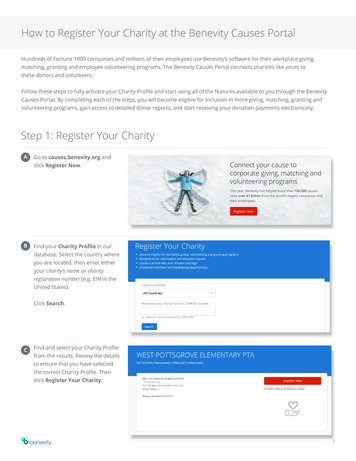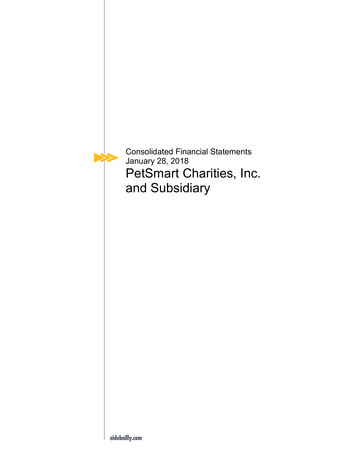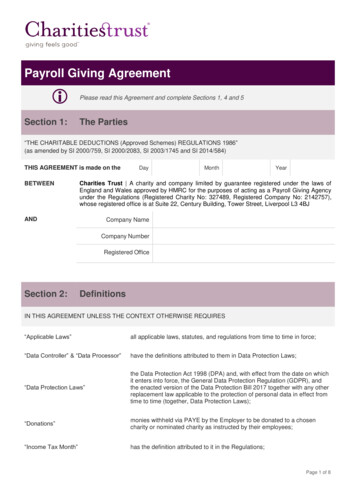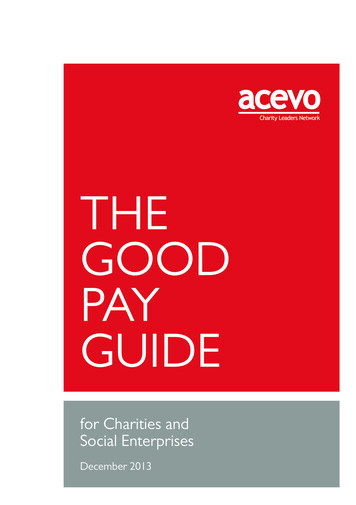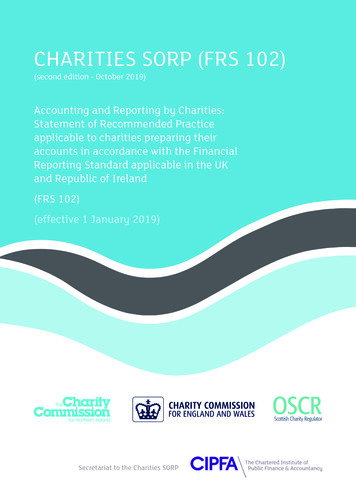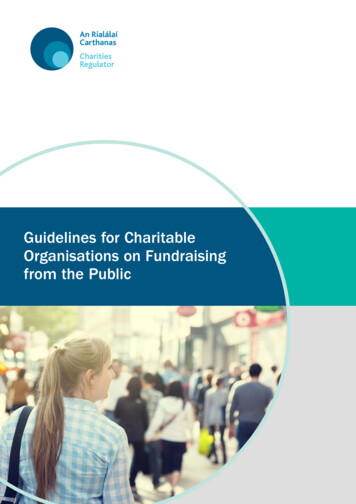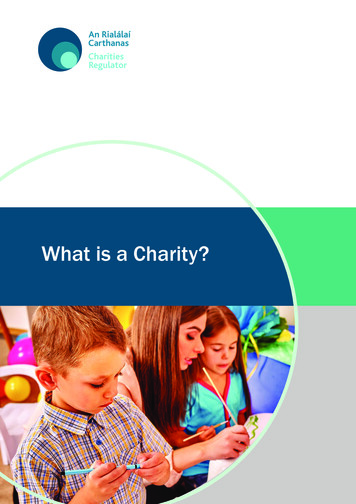
Transcription
What is a Charity?
These Guidelines are issuedby the Charities Regulatorpursuant to section 14(1)of the Charities Act 2009, toencourage and facilitate thebetter administration andmanagement of charitableorganisations (charities).
Charities Regulator1What is a Charity?Contents1. What does this guide explain? 32. Does your organisation pass the charity test?42.1 Does your organisation operate in the Republic of Ireland?52.2 What is your organisation’s charitable purpose?52.3 Does your organisation generate a ‘public benefit’?103. Is your organisation an ‘excluded body’?114. Is your charity’s name acceptable? 125. Charity Checklist 13LEGAL DISCLAIMERThis document is intended to provide general information in relation to how a charitable organisationis defined for the purposes of the Charities Act 2009. It is not, nor is it intended to be, a definitivestatement of the law in this area. Organisations should obtain their own independent legal advicewhen making decisions relating to any of the matters referred to in this document.
2What is a Charity?What is theCharities Regulator?The Charities Regulatory Authority or Charities Regulator for short is astatutory organisation, set up in October 2014, to regulate and protectcharities.We have a number of functions, such as setting up and maintainingthe Register of Charities. We also ensure that charities comply withtheir legal requirements, we carry out investigations into the affairs ofcharities and we issue guidelines and codes of conduct1.1See www.charitiesregulator.ie for more information about us.Charities Regulator
Charities Regulator1What is a Charity?What does thisguide explain?This guide explains what a charitable organisation is for the purposes of theCharities Act 20092.It looks at how we interpret the three main elements of this definition, which we refer to throughoutthis document as the ‘charity test’ and provides some clarity on excluded bodies.The guide aims to assist those considering setting up and applying to register as a charity. It mayalso be useful for trustees of existing charities, in particular those who are considering revisingtheir charitable purpose(s). Charity Trustees are the people who control and are legally responsiblefor the management of a charity. They must comply with their organisation’s governing document(constitution, deed of trust, rule book etc.), which provides the basis for everything their organisationdoes and how it does it.More detailed information is available for those considering setting up or applying to register as acharity on our website.All charities must apply to be registered with us. This is a legal requirement. If your organisation hadcharity status from the Revenue Commissioners on 16 October 2014, you are deemed to alreadybe registered as an Irish charity. If not, before beginning the registration application process, yourorganisation first needs to consider whether it fits the legal definition of a charity. This document willhelp you to understand how the law defines a charity.2See www.Irishstatutebook.ie for the details of the Charities Act 2009.3
42What is a Charity?Charities RegulatorDoes your organisationpass the charity test?The Charities Act 2009 sets out the requirements that your organisation must meetto be considered a charity. This definition of a charitable organisation can best beillustrated using this simple graphic, the ‘charity test’:The Charity TestOPERATESIN REPUBLICOF IRELANDCHARITABLEPURPOSEPUBLICBENEFITCHARITYTo pass the charity test and meet our registration requirements,your organisation must provide evidence that it: Operates in the Republic of Ireland Exists for a charitable purpose(s) Promotes this charitable purpose(s) only Carries out all activities to further this charitable purpose(s) Exists to benefit the public or a section of the public in Ireland,or elsewhere, through its charitable purpose(s) Is not an excluded bodyIf you are unsure whether your organisation meets these requirements, we strongly suggest youdiscuss this matter in detail within your organisation and formally record the decision made to applyto register your organisation, or not. You may wish to seek legal advice to assist you with this decisionmaking process.Charities can take any number of ‘models’ and ‘forms’. These models may include service providers,grant givers and membership organisations, to name a few. The forms a charity can take may includea company limited by guarantee (clg), other company types, associations or trusts. Whatever model orform a charity takes, it must pass the charity test in order to apply to register.
Charities Regulator5What is a Charity?Let us look at each element of the test in more detail.2.1 Does your organisationoperate in the Republicof Ireland?OPERATESIN REPUBLICOF IRELANDA charitable organisation that operates, orintends to operate or carry out activities, inIreland must apply to be registered. This doesnot mean that the people (or section of thepublic) that your organisation will benefit needto be in Ireland.For example, an organisation can operate inIreland with the main purpose of advancingeducation, by building schools in a number ofcommunities in a specific region of Africa, tobenefit the children and future generations ofthose communities.2.2 What is yourorganisation’scharitable purpose?CHARITABLEPURPOSEYour organisation’s ‘purpose’ is what it is set upto achieve. This purpose is usually set out in the‘objects clause’ of your organisation’s governingdocument. This purpose should conciselydescribe what outcomes the charity is set up toachieve, how it will achieve these outcomes, whowill benefit from these outcomes and where thebenefits will be felt.The Charities Act 2009 sets out specificcategories of charitable purposes. To satisfythis element of the charity test, your charity’spurpose must fall within one or more of thesecategories:The prevention or relief of poverty oreconomic hardshipThe advancement of educationThe advancement of religionAny other purpose that is of benefit tothe community.
6What is a Charity?Charities RegulatorCHARITABLEPURPOSEPrevention or reliefof poverty or econmichardshipAdvancementof EducationTHE WHATAND THE HOWRelieving povertyand economic hardshipby providing freemeals, clothing andsleeping bagsAdvancing educationby supporting a schoolby the provision ofbooks and otherlearning materialsThe homeless inCork city andsurrounding areasStreet childrenin MumbaiTHE WHO ANDTHE WHEREExamples of how a charitable purpose is set out under two categories of charitable purpose.Let’s consider each of the four categories of charitable purposes.CATEGORY 1:The prevention or relief of povertyor economic hardshipPoverty and economic hardship do not necessarilymean just a lack of money or material things. It mayalso relate to the impact that a lack of money ormaterial things has on a person.For example, your organisation could fall into thiscategory if it exists to provide money managementand debt advice, or training in work skills to improveemployment prospects.What constitutes the prevention or relief of poverty oreconomic hardship will vary depending on where andwith whom your organisation works.For example, an organisation working in one of theworld’s poorest regions might address the lack ofbasic essentials such as clothing or food, but anorganisation working in Ireland might help low-incomefamilies by providing gifts for children at Christmas.CATEGORY 2:The advancement of educationA wide range of experiences can be deemededucational and people can learn in manyways. The definition of this purpose, as withthe others, is not narrowly defined or static.Schools, colleges, pre-schools, playgroups,research bodies, professional institutes, thinktanks, museums and libraries could fall withinthis category of charitable purpose.To advance education, your organisation’swork must support education, but it does notnecessarily need to directly provide structuredlearning.For example, if your organisation exists tobuild schools in a developing country orprovide school books to children of lowincome families in Ireland, it could fall withinthis category.
Charities Regulator7What is a Charity?CATEGORY 3:The advancement of religionThe advancement of communitydevelopment, including rural or urbanregenerationThe Charities Act 2009 does not contain adefinition of religion. However, existing case lawhas established that a religion has two coreelements:Organisations that fall within this sub-categorysupport people and community groups toimprove the quality of life for the wholecommunity. Remember, community does not justmean a locality; it can also refer to an interest oridentity, for example ethnic origin.Belief in a ’Supreme Being’Faith and worship of that ’Supreme Being’To advance religion, your organisation’s workmust support a religion that contains thetwo core elements outlined, but it does notnecessarily need to be a religious body.For example, if your organisation exists to raiseawareness of a religious belief through thedissemination of religious books or films or toorganise religious pilgrimages or retreats, itcould fall within this category.Unlike other jurisdictions, donations or gifts forthe advancement of religion are presumed to beof public benefit, unless the contrary is proved.However, a donation or gift is not deemed to befor the advancement of religion if it is made to,or for the benefit of, an organisation or cult, thatemploys oppressive psychological manipulationof its followers or to gain new followers or whosemain objective is to make a profit.CATEGORY 4:Any other purpose that is ofbenefit to the communityWhile this is a broad category, the legislationprovides further detail on what is deemed acharitable purpose under this heading:The advancement of community welfare,including the relief of those in need byreason of youth, age, ill-health or disabilityIn addition to the more obvious organisationsthat could fall within this sub-category, such asmeals-on-wheels or youth clubs, organisationsset up to advance community welfare couldinclude those providing specialist care oraccommodation to the elderly, or those providingspecialist advice or equipment to disabledpeople.Regeneration is the process of reversing theeconomic, physical and social decline of placeswhere the need for improvement can clearly beidentified.The promotion of civic responsibilityor voluntary workThis involves developing and teaching civicvalues for the good of a community or societyas a whole. For example, it might includeorganisations that exist to promote democracyand equality, or encourage engagement withsocial processes.The promotion of voluntary work is the promotionof the values and benefits that volunteeringcan bring, both to the volunteers and thosewho benefit from their activities. Organisationsthat fall within this sub-category include thosethat encourage organisations to improve theircapacity to support and train volunteers, ororganisations that provide a service linkingvolunteers to volunteering opportunities.However, the fact that a charity may havevolunteers working for it, does not mean that thecharity promotes civic responsibility or voluntarywork.The promotion of health, including theprevention or relief of sickness, diseaseor human sufferingThe promotion of health generally meansthat the organisation advances physical ormental health, conventional medicine andcomplementary or alternative therapies.Organisations that fall within this sub-categorycould focus on curing specific diseases andillnesses, relieving symptoms or providingsupport to families of the terminally ill.
8The promotion of health could also includeorganisations that exist to help people maintainor improve their health by providing dietaryguidance, counselling or support, or undertakingmedical research.The advancement of conflict resolutionor reconciliationThis sub-category is very broad and relates toorganisations that exist to resolve or preventconflict or disputes between individuals andcommunities.It could include organisations that exist to relievethe suffering, poverty and distress that arisesfrom conflict, either nationally or internationally.Organisations that fall within this categorymight identify the causes of conflict and seekresolutions.Organisations that promote restorative justiceand organisations that offer familial counsellingor mediation services could also fall within thiscategory.The promotion of religious or racial harmonyand harmonious community relationsThis sub-category relates to social inclusion.Organisations that fall within this sub-categorycould include those that actively promote thelessening of conflict between people fromdifferent races, religions or belief systems. Suchorganisations could work on a local, regional,national or international basis.The protection of the natural environmentand the advancement of environmentalsustainabilityThese two sub-categories are very similar. Theyboth relate to the preservation and conservationof the natural environment and the promotionof sustainable development. Organisationsthat exist to protect or conserve a specific plantor animal species, or promote energy-savingmeasures or the use of a renewable energysource may fall within these categories.What is a Charity?Charities RegulatorThe advancement of the efficient andeffective use of the property of charitableorganisationsThis sub-category could include organisationsthat exist to ensure that other charitableorganisations are well run or allow theirresources to be used more effectively. Anorganisation with this purpose may providesupport and advisory services to charities toimprove their management, administration andoperations through training.The prevention or relief of sufferingof animalsOrganisations that fall within this sub-categoryexist to prevent cruelty towards animals orrelieve the suffering of animals. This couldinclude rescuing or re-homing animals, providingveterinary treatment or running animal shelters.The advancement of the arts, culture,heritage or sciencesThis is a broad sub-category and coversorganisations working in areas such as art,music, theatre, literature, language, dance andso on. An organisation that exists to providearts venues and facilities or to encourage highstandards in the arts could fall within this subcategory.Advancing heritage includes preserving historicland, buildings and items, as well as preservingor maintaining particular traditions.Finally, the advancement of science couldinclude organisations that exist to carry outscientific research or disseminate researchfindings, or encourage engagement with thesciences and those supporting the work ofscientific bodies.The integration of those who aredisadvantaged, and the promotionof their full participation, in societyThis involves helping people who aredisadvantaged. The disadvantage may bepermanent (such as terminal ill health or adisability) or temporary (such as unemploymentor upon release from prison or following abereavement).
Charities RegulatorWhat is a Charity?SummaryTo fall within one of the four categories of charitable purpose outlined in the Charties Act 2009, yourorganisation must exist for a reason that will further that purpose in some way. The legislation does notprovide a definitive list of accepted organisation types. Neither does it specify how your organisation’scharitable purpose(s) must be furthered. We will examine this on a case by case basis.Once you have agreed your organisation’s main purpose(s) – i.e.the what, the how, the who and the where – you and the board oftrustees should consider four key questions: Is your organisation established for a charitable purpose(s)only? Do all of the activities your organisation undertakes (or plansto undertake) relate directly to furthering the charitablepurpose(s)? Does your organisation apply all of its income and propertytowards that charitable purpose(s)? Is your organisation’s purpose(s) of public benefit?9
10What is a Charity?2.3 Does your organisationgenerate a ‘public benefit’?PUBLICBENEFITWe have looked at the requirement for yourorganisation to operate in the Republic ofIreland. We have also looked at the types ofcharitable purpose that your organisation mighthave and whether it could satisfy that element ofthe charity test. Now let’s consider whether yourorganisation’s purpose(s) generates a ‘publicbenefit’.First, let’s clarify what we mean by a ‘publicbenefit’.Charities RegulatorFor example, an organisation set up to raisefunds for a person to receive medical treatmentoverseas for a rare illness does not have apublic benefit as the monies raised will benefit aspecific individual. This is a private benefit.On the other hand, an organisation set up tosupport sufferers of a particular rare illness(whether by fundraising for treatment, providingrespite, funding a research study or all of theseactivities) will have a public benefit, even if thenumber of sufferers is very small. As long asall sufferers of that rare illness can access thesame supports, the organisation is providing abenefit to a specific section of the public.It is possible for some private benefit to occur,but this must be necessary, reasonable andancillary to the public benefit. For example, ifyour organisation has a paid employee, there is aprivate benefit to that employee. In this case, youshould be able to demonstrate that employingsomeone is necessary for your organisation toprovide the public benefit and the employee’spay and conditions are reasonable.An organisation’s purpose(s) must benefit thepublic or a section of the public in Ireland orelsewhere. The benefit your organisation’spurpose(s) provides should be identifiable.An organisation that benefits only one personcannot be legally regarded as a charity. However,the beneficiaries may be limited to a class ofpeople, as long as the organisation does notput restrictions within that class or, if it does,that any such restrictions are reasonable andjustified.It is possible forsome private benefitto occur, but thismust be necessary,reasonable andancillary to the publicbenefit.
Charities Regulator3What is a Charity?11Is your organisationan ‘excluded body’?Let’s look at ‘excluded bodies’ and explain why some organisations are not allowed toregister as a charity.Firstly, organisations that do not meet each element of the charity test outlined above are unable tobe registered as a charity. The legislation also sets out a number of exclusions, specifying the types oforganisations that are not, and cannot become, charities.The most obvious organisations that are not and cannot become charities are, bodies that promoteactivities that are unlawful, contrary to public morality, contrary to public policy or in support of terrorismor terrorist activity.Less obvious organisations that are not and cannot become charities include, trade unions orrepresentative bodies of employers and chambers of commerce. Other organisations specified in thelegislation include:Political parties or bodies that promote a political party, cause or candidateHowever, there can be exceptions if the promotion of that cause relates directly to the advancementof the charitable purpose(s) of the organisation. For example, an organisation that provides servicesto people with disabilities and also campaigns for better services for people with disabilities may stillbe considered a charity. Please see our ‘Guidance on Charities and the Promotion of Political Causes’document for more detailed information on this topic.Organisations established solely for the promotion of athletic or amateur games or sportsNot all sports-related bodies are automatically excluded3. For example, a dragon boat club for cancersurvivors and their families in a particular part of Ireland may be considered a charity under theadvancement of community welfare and the promotion of health.3Excluded sporting bodies are listed in the Section 235 of the Taxes Consolidation Act 1997.
12What is a Charity?4Charities RegulatorIs your organisation’sname acceptable?If you are still considering setting up a charity, the final matter you need to consider isyour organisation’s name.Choosing the wrong name could prevent your organisation from being registered as a charity, even if youpass the charity test and are not an excluded body.When deciding on a name, please consider if your organisation’sname: Is the same or very similar to an existing charity? Could mislead people regarding its purpose(s) or activities? Could lead people to incorrectly believe it is connected toanother body? Might cause offence to a reasonable person?If you answer ‘yes’ to any of these questions, you should consider changing your organisation’s name.
Charities Regulator513What is a Charity?CharitychecklistNow that you are aware of the elements of the charity test and have had a chance to considerwhat bodies are excluded from becoming charities, here is our checklist again to help you decidewhether your organisation will meet our registration requirements:epublicOperates in the Rof Ireland?bleExists for a charitapurpose(s)?aritablePromotes this chpurpose(s) only ?tivitiesCarries out all acritableto further this chapurpose(s)?e publicExists to benefit the public inor a section of there, throughIreland, or elsewhose(s)?its charitable purpd body’Is not an ‘exclude
Document Reference No RR GLS 8.2.1 001 Rev 001July, 2018Charities Regulator3 Georges DockIFSCDublin 1D01 X5X0Telephone: 01 633 1500www.charitiesregulator.ie Charities Regulator 2018
The guide aims to assist those considering setting up and applying to register as a charity. It may . also be useful for trustees of existing charities, in particular those who are considering revising their charitable purpose(s). Charity Trustees are the people who control and are legally responsible for the management of a charity.

